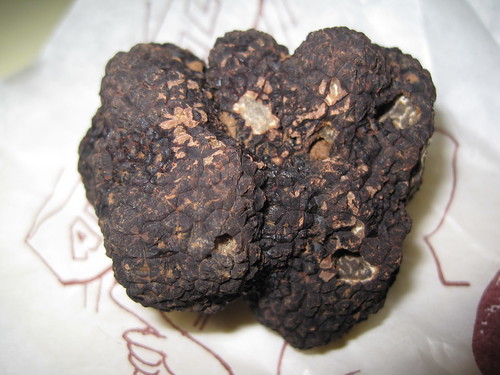Adam Gopnik, at the end of the second essay ("The Strike") in his collection
Paris to the Moon, writes:
The turkey, not quite incidentally, was so much better than any other turkey
I have ever eaten that it might have been an entirely different kind of bird.
We (by which I mean my family and I) are having similar experiences with la
volaille. On the morning of Christmas Eve, I went down to Les Arceaux to pick
up the dinde de Noël my wife had ordered the week before from a local
producer. A flock of birds, 30 or so, was waiting behind the plexiglass counter
of trailer, each marked with a weight, price, and name (one mine). I didn't see
a bird over 5 kilos. Mine, at 3 kg, would be considered a smallish, but not
tiny bird. The producer asked me if I wanted him to finish the turkey; I could
have brought it home with feet, head, and lungs attached if I'd desired. I did
not. He whacked off the extremities, removed the organs, replaced the ones
normally considered edible, I paid him and brought home a fowl that if not
overcooked (it was, slightly) could have been the best we'd ever eaten.
We've been getting chicken from the same producer: whole birds and wings, plump
meaty wings from well-exercised birds, driven up into the trees several times
each day, perhaps, by a well-trained French farm dog. My wife is permanently
astounded at the smell of the chicken, or rather the lack of smell. Sushi-grade
poulet, this is. Even supermarket chicken seems years fresher than its
American counterpart. We don't completely understand the factors. Is there a
shorter supply chain? We can buy directly from a producer, but I get the sense
that mass market birds also spend less time in carcass state around here. A
very good thing. Unconsolidated industry? Geography? We'll look into it.
One thing for certain is that the French still, in the 21st century, expect
their ingredients to be fresh and their meals to be well made. Yesterday I rode
in the Font-Romeu télécabine with a pair of 20-something French dudes, and
evesdropped on their conversation about food. One of them wearing one of those
ridiculous rainbow poly fleece dreadlock ski hats, not something I'd expect to see on the head of a
gourmet. "What's for dinner?" "Cuisse de canard (duck leg, roasted)." "With
what?" "Potatoes." "Boiled? I'd prefer a gratin." "That's a little heavy to go
with duck, in my opinion ..." They then veered into a reminscence of favorite
meals past. This wasn't the first time I'd experienced this; it's a bit like living in the Food Channel here.


Comments
Re: Dotted JSON namespaces
Author: Tom Kralidis
Wouldn't this result in a bulkier encoding? At least with JDIL, the URIs are defined once (at the top/header) and the prefixes are shorthand refs to them.
I do agree that your proposal above is closer to code.
Re: Dotted JSON namespaces
Author: Sean
A little bulkier, yes, but it's not going to add up to a lot of extra bytes relative to the accompanying coordinates. Flatter namespaces will certainly be easier on the eyes.